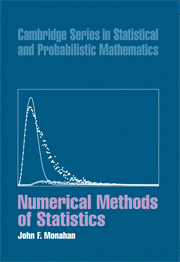Book contents
- Frontmatter
- Contents
- Preface
- 1 Algorithms and Computers
- 2 Computer Arithmetic
- 3 Matrices and Linear Equations
- 4 More Methods for Solving Linear Equations
- 5 Regression Computations
- 6 Eigenproblems
- 7 Functions: Interpolation, Smoothing, and Approximation
- 8 Introduction to Optimization and Nonlinear Equations
- 9 Maximum Likelihood and Nonlinear Regression
- 10 Numerical Integration and Monte Carlo Methods
- 11 Generating Random Variables from Other Distributions
- 12 Statistical Methods for Integration and Monte Carlo
- 13 Markov Chain Monte Carlo Methods
- 14 Sorting and Fast Algorithms
- Table of Programs and Demonstrations
- Author Index
- Subject Index
1 - Algorithms and Computers
Published online by Cambridge University Press: 21 March 2011
- Frontmatter
- Contents
- Preface
- 1 Algorithms and Computers
- 2 Computer Arithmetic
- 3 Matrices and Linear Equations
- 4 More Methods for Solving Linear Equations
- 5 Regression Computations
- 6 Eigenproblems
- 7 Functions: Interpolation, Smoothing, and Approximation
- 8 Introduction to Optimization and Nonlinear Equations
- 9 Maximum Likelihood and Nonlinear Regression
- 10 Numerical Integration and Monte Carlo Methods
- 11 Generating Random Variables from Other Distributions
- 12 Statistical Methods for Integration and Monte Carlo
- 13 Markov Chain Monte Carlo Methods
- 14 Sorting and Fast Algorithms
- Table of Programs and Demonstrations
- Author Index
- Subject Index
Summary
Introduction
Discussing algorithms before computers emphasizes the point that algorithms are valuable mathematical constructs in themselves and exist even in the absence of computers. An algorithm is a list of instructions for the completion of a task. The best examples of algorithms in everyday life are cooking recipes, which specify how a list of ingredients are to be manipulated to produce a desired result. For example, consider the somewhat trivial recipe for cooking a three-minute egg. The recipe (or algorithm) for such a task exemplifies the need to take nothing for granted in the list of instructions.
Algorithm Three-Minute Egg
Put water in a pan.
Turn on the heat.
When the water boils, flip over the egg timer.
When the timer has run out, turn off the heat.
Pour some cold water in the pan to cool the water.
Remove egg.
Although this algorithm may appear trivial to most readers, detailed examination further emphasizes (or belabors) how clear and unambiguous an algorithm must be. First, the receiver of these instructions, call it the actor, must recognize all of the jargon of food preparation: water, pan, egg, egg timer, boil, and so forth. The actor must recognize constructions: “put ____ in ____”; “when ____, do ____.” Some parts of these instructions are unnecessary: “to cool the water.” If the actor is an adult who understands English, this may be a fine algorithm. To continue to belabor the point, the actor can only do what the instructions say.
- Type
- Chapter
- Information
- Numerical Methods of Statistics , pp. 1 - 10Publisher: Cambridge University PressPrint publication year: 2001



